Rational Design of Simple Organocatalysts for the HSiCl3 Enantioselective Reduction of (E)-N-(1-Phenylethylidene)aniline
Abstract
1. Introduction
2. Results and Discussion
2.1. Catalyst Screening
2.2. Kinetic Studies
2.3. Structural Catalyst Optimization
2.4. Continuous Flow Reduction
2.5. Computational Studies with Simplified Model Compounds
2.6. Mechanistic Studies with Real Compounds
3. Materials and Methods
3.1. Experimental Section
3.2. General Procedure for the Synthesis of Imine 1
3.3. General Procedure for the Synthesis of Piv-l-Pro
3.4. General Procedure for the l-Proline-Organocatalysts Synthesis (3–16)
3.5. General Procedure for the Asymmetric Reduction with HSiCl3
3.6. General Procedure for Kinetic Studies
3.7. General Procedure for the Asymmetric Reduction with HSiCl3 in Flow Process
4. Conclusions
Supplementary Materials
Author Contributions
Funding
Institutional Review Board Statement
Informed Consent Statement
Data Availability Statement
Acknowledgments
Conflicts of Interest
Sample Availability
References
- Nugent, T.C. Chiral Amine Synthesis Methods, Developments and Applications; Wiley-VCH: Weinheim, Germany, 2010. [Google Scholar] [CrossRef]
- Nugent, T.C.; El-Shazly, M. Chiral Amine Synthesis—Recent Developments and Trends for Enamide Reduction, Reductive Amination, and Imine Reduction. Adv. Synth. Catal. 2010, 352, 753–819. [Google Scholar] [CrossRef]
- Ghislieri, D.; Turner, N.J. Biocatalytic Approaches to the Synthesis of Enantiomerically Pure Chiral Amines. Top. Catal. 2014, 57, 284–300. [Google Scholar] [CrossRef]
- Phillips, A.M.F.; Pombeiro, A.J.L. Recent advances in organocatalytic enantioselective transfer hydrogenation. Org. Biomol. Chem. 2017, 15, 2307–2340. [Google Scholar] [CrossRef]
- Herrera, R.P. Organocatalytic Transfer Hydrogenation and Hydrosilylation Reactions. Top. Curr. Chem. 2016, 374, 29. [Google Scholar] [CrossRef] [PubMed]
- Rossi, S.; Benaglia, M.; Massolo, E.; Raimondi, L. Organocatalytic strategies for enantioselective metal-free reductions. Catal. Sci. Technol. 2014, 4, 2708–2723. [Google Scholar] [CrossRef]
- Foubelo, F.; Yus, M. Catalytic Asymmetric Transfer Hydrogenation of Imines: Recent Advances. Chem. Rec. 2015, 15, 907–924. [Google Scholar] [CrossRef] [PubMed]
- Wakchaure, V.N.; Kaib, P.S.J.; Leutzsch, M.; List, B. Disulfonimide-Catalyzed Asymmetric Reduction of N-Alkyl Imines. Angew. Chem. Int. Ed. 2015, 54, 11852–11856. [Google Scholar] [CrossRef]
- Genoni, A.; Benaglia, M.; Mattiolo, E.; Rossi, S.; Raimondi, L.; Barrulas, P.C.; Burke, A.J. Synthesis of an advanced precursor of Rivastigmine: Cinchona-derived quaternary ammonium salts as organocatalysts for stereoselective imine reductions. Tetrahedron Lett. 2015, 56, 5752–5756. [Google Scholar] [CrossRef]
- Genoni, A.; Benaglia, M.; Massolo, E.; Rossi, S. Stereoselective metal-free catalytic synthesis of chiral trifluoromethyl aryl and alkyl amines. Chem. Commun. 2013, 49, 8365–8367. [Google Scholar] [CrossRef] [PubMed]
- Yilmaz, N.; Sekeroglu, B. Student Performance Classification Using Artificial Intelligence Techniques. In Advances in Intelligent Systems and Computing; Springer: Cham, Switzerland, 2020; Volume 1095. [Google Scholar] [CrossRef]
- Brenna, D.; Pirola, M.; Raimondi, L.; Burke, A.J.; Benaglia, M. A stereoselective, catalytic strategy for the in-flow synthesis of advanced precursors of rasagiline and tamsulosin. Bioorg. Med. Chem. 2017, 25, 6242–6247. [Google Scholar] [CrossRef]
- Han, Z.S.; Zhang, L.; Xu, Y.; Sieber, J.D.; Marsini, M.A.; Li, Z.; Reeves, J.T.; Fandrick, K.R.; Patel, N.D.; Desrosiers, J.-N.; et al. Efficient Asymmetric Synthesis of Structurally Diverse P-Stereogenic Phosphinamides for Catalyst Design. Angew. Chem. Int. Ed. 2015, 54, 5474–5477. [Google Scholar] [CrossRef] [PubMed]
- Sugiura, M.; Ashikari, Y.; Takahashi, Y.; Yamaguchi, K.; Kotani, S.; Nakajima, M. Lewis Base-Catalyzed Enantioselective Conjugate Reduction of β,β-Disubstituted α,β-Unsaturated Ketones with Trichlorosilane: E/Z-Isomerization, Regioselectivity, and Synthetic Applications. J. Org. Chem. 2019, 84, 11458–11473. [Google Scholar] [CrossRef] [PubMed]
- Orlandi, M.; Tosi, F.; Bonsignore, M.; Benaglia, M. Metal-Free Reduction of Aromatic and Aliphatic Nitro Compounds to Amines: A HSiCl3-Mediated Reaction of Wide General Applicability. Org. Lett. 2015, 17, 3941–3943. [Google Scholar] [CrossRef]
- Orlandi, M.; Benaglia, M.; Tosi, F.; Annunziata, R.; Cozzi, F. HSiCl3-Mediated Reduction of Nitro-Derivatives to Amines: Is Tertiary Amine-Stabilized SiCl2 the Actual Reducing Species? J. Org. Chem. 2016, 81, 3037–3041. [Google Scholar] [CrossRef] [PubMed]
- Chen, L.; Wang, C.; Zhou, L.; Sun, J. Chiral 2,3-Disubstituted Indolines from Indoles and Aldehydes by Organocatalyzed Tandem Synthesis Involving Reduction by Trichlorosilane. Adv. Synth. Catal. 2014, 356, 2224–2230. [Google Scholar] [CrossRef]
- Fu, Y.; Sun, J. HMPA-Catalyzed Transfer Hydrogenation of 3-Carbonyl Pyridines and Other N-Heteroarenes with Trichlorosilane. Molecules 2019, 24, 401. [Google Scholar] [CrossRef]
- Wang, T.; Di, X.; Wang, C.; Zhou, L.; Sun, J. Reductive Hydrazination with Trichlorosilane: A Method for the Preparation of 1,1-Disubstituted Hydrazines. Org. Lett. 2016, 18, 1900–1903. [Google Scholar] [CrossRef]
- Frogneux, X.; Blondiaux, E.; Thuéry, P.; Cantat, T. Bridging Amines with CO2: Organocatalyzed Reduction of CO2 to Aminals. ACS Catal. 2015, 5, 3983–3987. [Google Scholar] [CrossRef]
- Hao, L.; Zhao, Y.; Yu, B.; Yang, Z.; Zhang, H.; Han, B.; Gao, X.; Liu, Z. Imidazolium-Based Ionic Liquids Catalyzed Formylation of Amines Using Carbon Dioxide and Phenylsilane at Room Temperature. ACS Catal. 2015, 5, 4989–4993. [Google Scholar] [CrossRef]
- Nicholls, R.L.; McManus, J.A.; Rayner, C.M.; Morales-Serna, J.A.; White, A.J.P.; Nguyen, B.N. Guanidine-Catalyzed Reductive Amination of Carbon Dioxide with Silanes: Switching between Pathways and Suppressing Catalyst Deactivation. ACS Catal. 2018, 8, 3678–3687. [Google Scholar] [CrossRef]
- Hulla, M.; Laurenczy, G.; Dyson, P.J. Mechanistic Study of the N-Formylation of Amines with Carbon Dioxide and Hydrosilanes. ACS Catal. 2018, 8, 10619–10630. [Google Scholar] [CrossRef]
- Guizzetti, S.; Benaglia, M. Trichlorosilane-Mediated Stereoselective Reduction of C=N Bonds. Eur. J. Org. Chem. 2010, 29, 5529–5541. [Google Scholar] [CrossRef]
- Jones, S.; Warner, C.J.A. Trichlorosilane mediated asymmetric reductions of the C=N bond. Org. Biomol. Chem. 2012, 10, 2189–2200. [Google Scholar] [CrossRef] [PubMed]
- Qinglong, S.; Zhangpei, C.; Jianshe, H. Recent Advances in Organocatalyzed Asymmetric Hydrosilylations. Curr. Org. Chem. 2018, 22, 557–580. [Google Scholar] [CrossRef]
- Malkov, A.V.; Stewart-Liddon, A.J.P.; McGeoch, G.D.; Ramírez-López, P.; Kočovský, P. Catalyst development for organocatalytic hydrosilylation of aromatic ketones and ketimines. Org. Biomol. Chem. 2012, 10, 4864–4877. [Google Scholar] [CrossRef]
- Pan, W.; Deng, Y.; He, J.-B.; Bai, B.; Zhu, H.-J. Highly efficient asymmetric-axle-supported N-O amides in enantioselective hydrosilylation of ketimines with trichlorosilane. Tetrahedron 2013, 69, 7253–7257. [Google Scholar] [CrossRef]
- Wang, Z.; Wang, C.; Zhoub, L.; Sun, J. L-Pipecolinic acid derived Lewis base organocatalyst for asymmetric reduction of N-aryl imines by trichlorosilane: Effects of the side amide group on catalytic performances. Org. Biomol. Chem. 2013, 11, 787–797. [Google Scholar] [CrossRef]
- Pei, Y.-N.; Deng, Y.; Li, J.-L.; Liu, L.; Zhu, H.-J. New chiral biscarboline N,N’-dioxide derivatives as catalyst in enantioselective reduction of ketoimines with trichlorosilane. Tetrahedron Lett. 2014, 55, 2948–2952. [Google Scholar] [CrossRef]
- Brenna, D.; Porta, R.; Massolo, E.; Raimondi, L.; Benaglia, M. A New Class of Low-Loading Catalysts for Highly Enantioselective, Metal-Free Imine Reduction of Wide General Applicability. ChemCatChem 2017, 9, 941–945. [Google Scholar] [CrossRef]
- Skrypai, V.; Varjosaari, S.E.; Azam, F.; Gilbert, T.M.; Adler, M.J. Chiral Brønsted Acid-Catalyzed Metal-Free Asymmetric Direct Reductive Amination Using 1-Hydrosilatrane. J. Org. Chem. 2019, 84, 5021–5026. [Google Scholar] [CrossRef]
- Chen, W.; Tan, C.-H.; Wang, H.; Ye, X. The Development of Organocatalytic Asymmetric Reduction of Carbonyls and Imines Using Silicon Hydrides. Eur. J. Org. Chem. 2021, 21, 3091–3112. [Google Scholar] [CrossRef]
- Jones, S.; Li, X. Synthesis of chiral β-amino acid derivatives by asymmetric hydrosilylation with an imidazole derived organocatalyst. Tetrahedron 2012, 68, 5522–5532. [Google Scholar] [CrossRef]
- Jones, S.; Zhao, P. Evaluating dynamic kinetic resolution strategies in the asymmetric hydrosilylation of cyclic ketimines. Tetrahedron: Asymmetry 2014, 25, 238–244. [Google Scholar] [CrossRef]
- Ye, J.; Wang, C.; Chen, L.; Wu, X.; Zhou, L.; Sun, J. Chiral Lewis Base-Catalyzed, Enantioselective Reduction of Unprotected β-Enamino Esters with Trichlorosilane. Adv. Synth. Catal. 2016, 358, 1042–1047. [Google Scholar] [CrossRef]
- Dai, X.; Weng, G.; Yu, S.; Chen, H.; Zhang, J.; Cheng, S.; Xu, X.; Yuan, W.; Wang, Z.; Zhang, X. One-pot diastereo- and enantioselective hydrosilylation–transacylation of α-acyloxy β-enamino esters. Org. Chem. Front. 2018, 5, 2787–2793. [Google Scholar] [CrossRef]
- Sugiura, M.; Kashiwagi, T.; Ito, M.; Kotani, S.; Nakajima, M. Stereoselective Synthesis of Nitrogen-Containing Compounds from Enamines. J. Org. Chem. 2017, 82, 10968–10979. [Google Scholar] [CrossRef] [PubMed]
- Dai, X.; Liu, M.; Huang, M.; Zhang, J.; Xu, X.; Yuan, W.; Zhang, X. Synthesis of Chiral α-Mercapto-β-acylamido Esters via One-pot Asymmetric Hydrosilylation-transacylation of α-Acylthio-β-Enamino Esters. Asian J. Org. Chem. 2019, 8, 456–461. [Google Scholar] [CrossRef]
- Zhang, Z.; Rooshenas, P.; Hausmann, H.; Schreiner, P.R. Asymmetric Transfer Hydrogenation of Ketimines with Trichlorosilane: Structural Studies. Synthesis 2009, 2009, 1531–1544. [Google Scholar] [CrossRef][Green Version]
- Li, X.; Reeder, A.T.; Torri, F.; Adams, H.; Jones, S. Mechanistic investigations of the asymmetric hydrosilylation of ketimines with trichlorosilane reveals a dual activation model and an organocatalyst with enhanced efficiency. Org. Biomol. Chem. 2017, 15, 2422–2435. [Google Scholar] [CrossRef]
- Bonsignore, M.; Benaglia, M.; Raimondi, L.; Orlandi, M.; Celentano, G. Enantioselective reduction of ketoimines promoted by easily available (S)-proline derivatives. Beilstein J. Org. Chem. 2013, 9, 633–640. [Google Scholar] [CrossRef]
- Dong, M.; Wang, J.; Wu, S.; Zhao, Y.; Ma, Y.; Xing, Y.; Cao, F.; Li, L.; Li, Z.; Zhu, H. Catalytic Mechanism Study on the 1,2- and 1,4-Transfer Hydrogenation of Ketimines and β-Enamino Esters Catalyzed by Axially Chiral Biscarboline-Based Alcohols. Adv. Synth. Catal. 2019, 361, 4602–4610. [Google Scholar] [CrossRef]
- Shaikh, I.R. Organocatalysis: Key Trends in Green Synthetic Chemistry, Challenges, Scope Towards Heterogenization, and Importance from Research and Industrial Point of View. J. Catal. 2014, 2014, 1–35. [Google Scholar] [CrossRef]
- Iwasaki, F.; Onomura, O.; Mishima, K.; Kanematsu, T.; Maki, T.; Matsumura, Y. First chemo- and stereoselective reduction of imines using trichlorosilane activated with N-formylpyrrolidine derivatives. Tetrahedron Lett. 2001, 42, 2525–2527. [Google Scholar] [CrossRef]
- Ever, Y.; Dimililer, K.; Sekeroglu, B. Comparison of Machine Learning Techniques for Prediction Problems. In Advances in Intelligent Systems and Computing; Springer: Cham, Switzerland, 2019; Volume 927. [Google Scholar] [CrossRef]
- Ge, X.; Qian, C.; Chen, X. Synthesis of novel carbohydrate-based valine-derived formamide organocatalysts by CuAAC click chemistry and their application in asymmetric reduction of imines with trichlorosilane. Tetrahedron Asymmetry 2014, 25, 1450–1455. [Google Scholar] [CrossRef]
- Ge, X.; Qian, C.; Yea, X.; Chen, X. Asymmetric reduction of imines with trichlorosilane catalyzed by valine-derived formamide immobilized onto magnetic nano-Fe3O4. RSC Adv. 2015, 5, 65402–65407. [Google Scholar] [CrossRef]
- Wagner, C.; Kotthaus, A.F.; Kirsch, S.F. The asymmetric reduction of imidazolinones with trichlorosilane. Chem. Commun. 2017, 53, 4513–4516. [Google Scholar] [CrossRef] [PubMed]
- Pedrosa, R.; Andres, J.M. Prolinamides as Asymmetric Organocatalysts. In Sustainable Catalysis: Without Metals or Other Endangered Elements; part 1; North, M., Ed.; RSC: London, UK, 2016; pp. 120–138. [Google Scholar]
- Becerril, J.; Bolte, M.; Burguete, M.I.; Galindo, F.; Garcia-España, E.; Luis, S.V.; Miravet, J.F. Efficient Macrocyclization of U-Turn Preorganized Peptidomimetics: The Role of Intramolecular H-Bond and Solvophobic Effects. J. Am. Chem. Soc. 2003, 125, 6677–6686. [Google Scholar] [CrossRef] [PubMed]
- Burguete, M.I.; Collado, M.; Escorihuela, J.; Luis, S.V. Efficient Chirality Switching in the Addition of Diethyzinc to Aldehydes in the Presence of Simple Chiral β-Amino Amides. Angew. Chem. Int. Ed. 2007, 46, 9002–9005. [Google Scholar] [CrossRef]
- Obregón-Zúñiga, A.; Juaristi, E. (2S,4R)-Hyp-(S)-Phe-OMe dipeptide supported on imidazolium tagged molecules as recoverable organocatalysts for asymmetric aldol reactions using water as reaction medium. Tetrahedron 2017, 73, 5373–5380. [Google Scholar] [CrossRef]
- Kanemitsu, T.; Umehara, A.; Haneji, R.; Nagata, K.; Itoh, T. A simple proline-based organocatalyst for the enantioselective reduction of imines using trichlorosilane as a reductant. Tetrahedron 2012, 68, 3893–3898. [Google Scholar] [CrossRef]
- Barrulas, P.C.; Genoni, A.; Benaglia, M.; Burke, A.J. Cinchona-Derived Picolinamides: Effective Organocatalysts for Stereoselective Imine Hydrosilylation. Eur. J. Org. Chem. 2014, 2014, 7339–7342. [Google Scholar] [CrossRef]
- Hu, F.-Z.; Chen, H.; Xu, X.-Y.; Yuan, W.-C.; Zhang, X.-M. Dynamic Kinetic Resolution in Enantioselective Reductive Amination of a-Branched Aldehydes by Lewis Base Organocatalyzed Hydrosilylation. ChemistrySelect 2017, 2, 4076–4078. [Google Scholar] [CrossRef]
- Xing, Y.; Wu, S.; Dong, M.; Wang, J.; Liu, L.; Zhu, H. Synthesis and application of axially chiral biscarbolines with functional N-O and sulfone for 1,2-transfer hydrogenations of ketimines. Tetrahedron 2019, 75, 130495. [Google Scholar] [CrossRef]
- Hu, X.-Y.; Zhang, M.-M.; Shu, C.; Zhang, Y.-H.; Liao, L.-H.; Yuan, W.-C.; Zhang, X.-M. Enantioselective Lewis-Base-Catalyzed Asymmetric Hydrosilylation of Substituted Benzophenone N-Aryl Imines: Efficient Synthesis of Chiral (Diarylmethyl)amines. Adv. Synth. Catal. 2014, 356, 3539–3544. [Google Scholar] [CrossRef]
- Warner, C.J.A.; Reeder, A.T.; Jones, S. P-Chiral phosphine oxide catalysed reduction of prochiral ketimines using trichlorosilane. Tetrahedron: Asymmetry 2016, 27, 136–141. [Google Scholar] [CrossRef]
- El-Fayyoumy, S.; Todd, M.H.; Richards, C.J. Can we measure catalyst efficiency in asymmetric chemical reactions? A theoretical approach. Beilstein J. Org. Chem. 2009, 5, 67. [Google Scholar] [CrossRef]
- Frisch, M.J.; Trucks, G.W.; Schlegel, H.B.; Scuseria, G.E.; Robb, M.A.; Cheeseman, J.R.; Scalmani, G.; Barone, V.; Mennucci, B.; Petersson, G.A.; et al. Gaussian 09, Revision, B.01; Gaussian, Inc.: Wallingford, CT, USA, 2010. [Google Scholar]
- Cortez, P.; Silva, A. Role of noncovalent interactions in the enantioselective reduction of aromatic ketimines with trichlorosilane. In Proceedings of the 5th FUture BUsiness TEChnology Conference (FUBUTEC), Porto, Portugal, 9–11 April 2008; pp. 5–12, ISBN 978-9077381-39-7. [Google Scholar]
- Onomura, O.; Kouchi, Y.; Iwasaki, F.; Matsumura, Y. New organic activators for the enantioselective reduction of aromatic imines with trichlorosilane. Tetrahedron Lett. 2006, 47, 3751–3754. [Google Scholar] [CrossRef]
- Reep, C.; Morgante, P.; Peverati, R.; Takenaka, N. Axial-Chiral Biisoquinoline N,N′-Dioxides Bearing Polar Aromatic C-H Bonds as Catalysts in Sakurai-Hosomi-Denmark Allylation. Org. Lett. 2018, 20, 5757–5761. [Google Scholar] [CrossRef] [PubMed]
- Warner, C.J.A.; Berry, S.S.; Jones, S. Evaluation of bifunctional chiral phosphine oxide catalysts for the asymmetric hydrosilylation of ketimines. Tetrahedron 2019, 75, 130733. [Google Scholar] [CrossRef]
- Entrena, A.; Campos, J.M.; Gallo, M.A.; Espinosa, A. Rules for Predicting the Conformational Behavior of Saturated Seven-Membered Heterocycles. ARKIVOC 2005, 6, 88–108. [Google Scholar] [CrossRef]
- Gawley, R.E. Do the Terms “% ee” and “% de” Make Sense as Expressions of Stereoisomer Composition or Stereoselectivity? J. Org. Chem. 2006, 71, 2411–2416. [Google Scholar] [CrossRef] [PubMed]
- Gautier, F.-M.; Jones, S.; Martin, S.J. Asymmetric reduction of ketimines with trichlorosilane employing an imidazole derived organocatalyst. Org. Biomol. Chem. 2009, 7, 229–231. [Google Scholar] [CrossRef] [PubMed]
- Pirkle, W.H.; Murray, P.G.; Rausch, D.J.; McKenna, S.T. Intermolecular 1H–1H Two-Dimensional Nuclear Overhauser Enhancements in the Characterization of a Rationally Designed Chiral Recognition System. J. Org. Chem. 1996, 61, 4769–4774. [Google Scholar] [CrossRef] [PubMed]

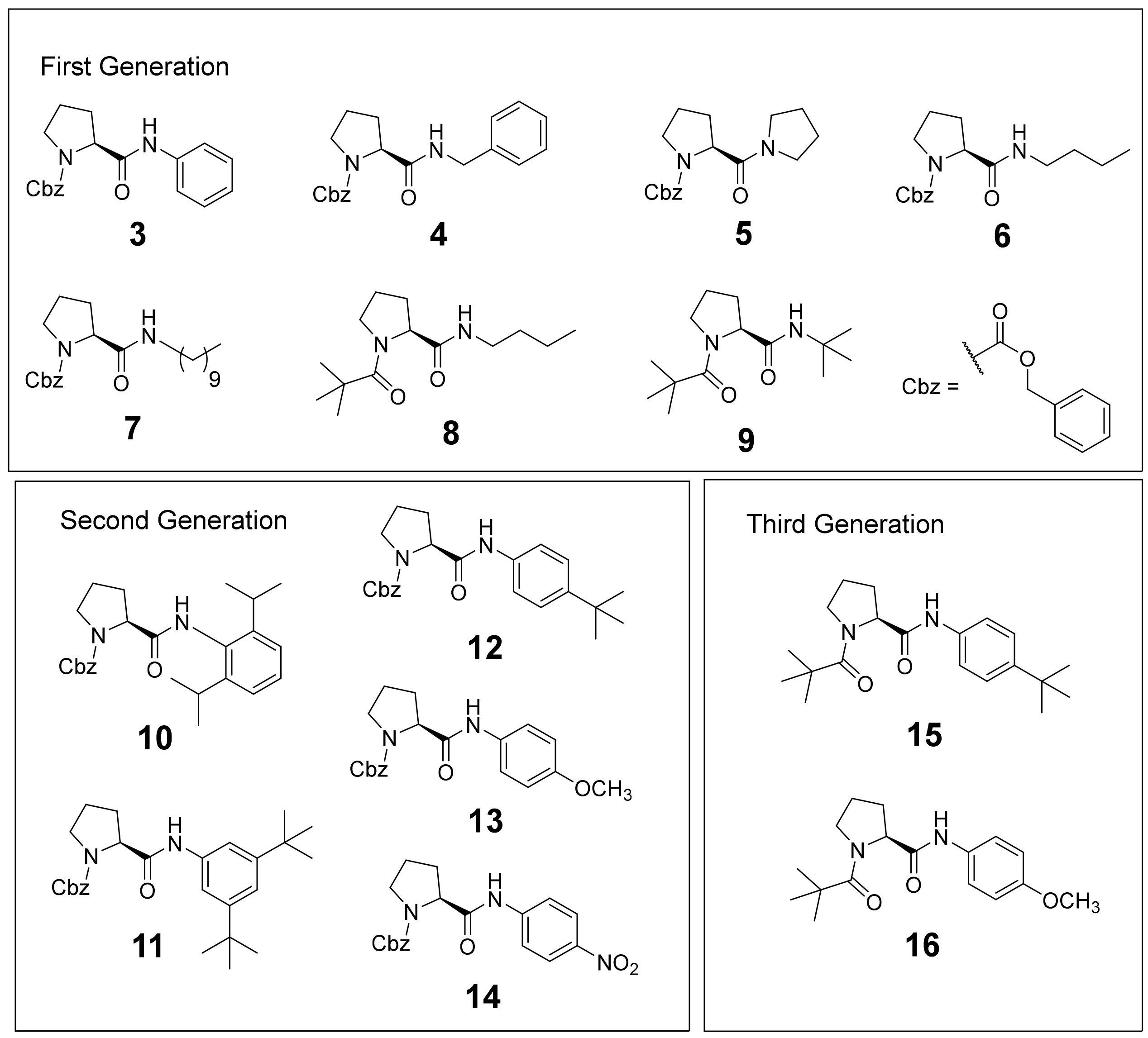
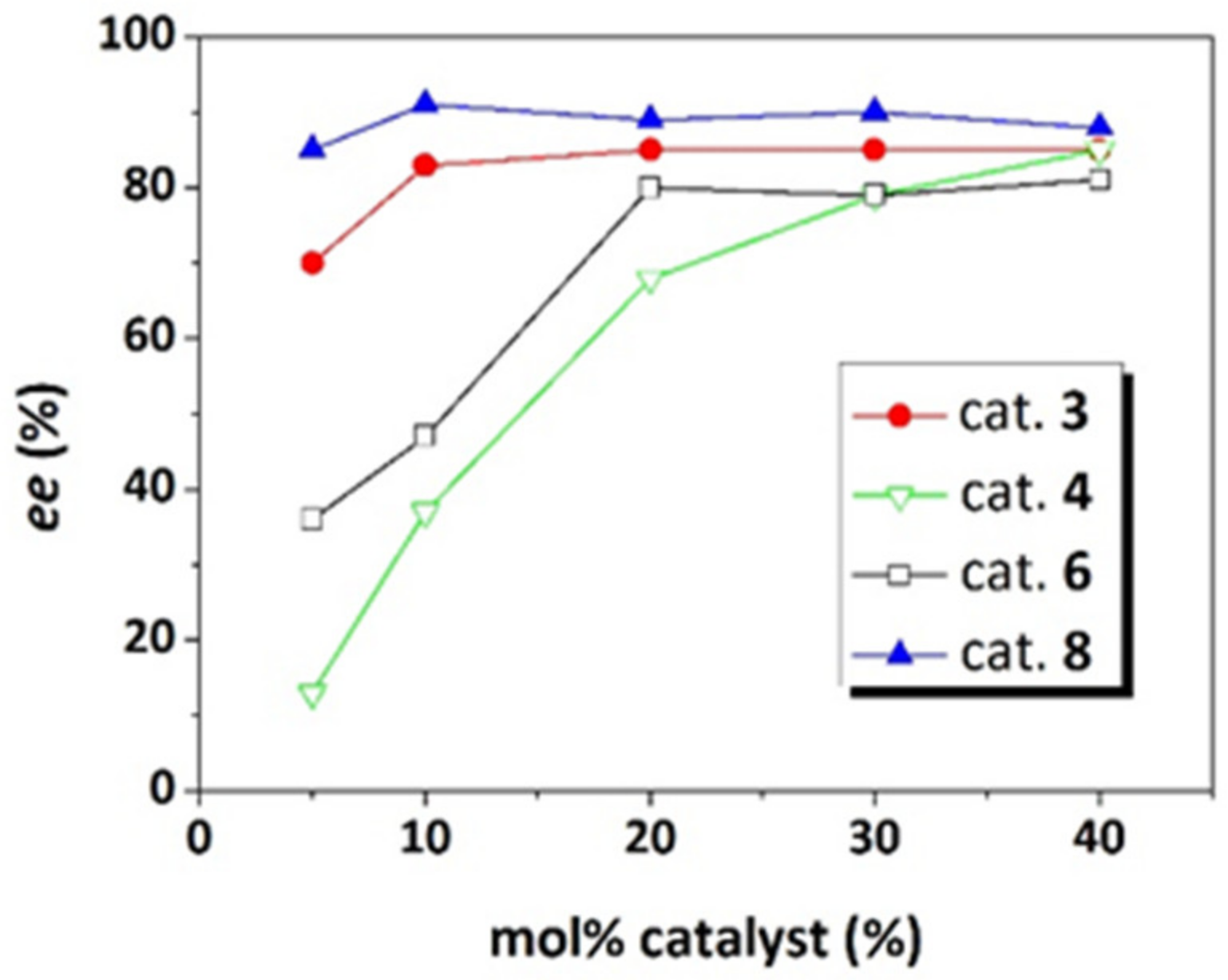

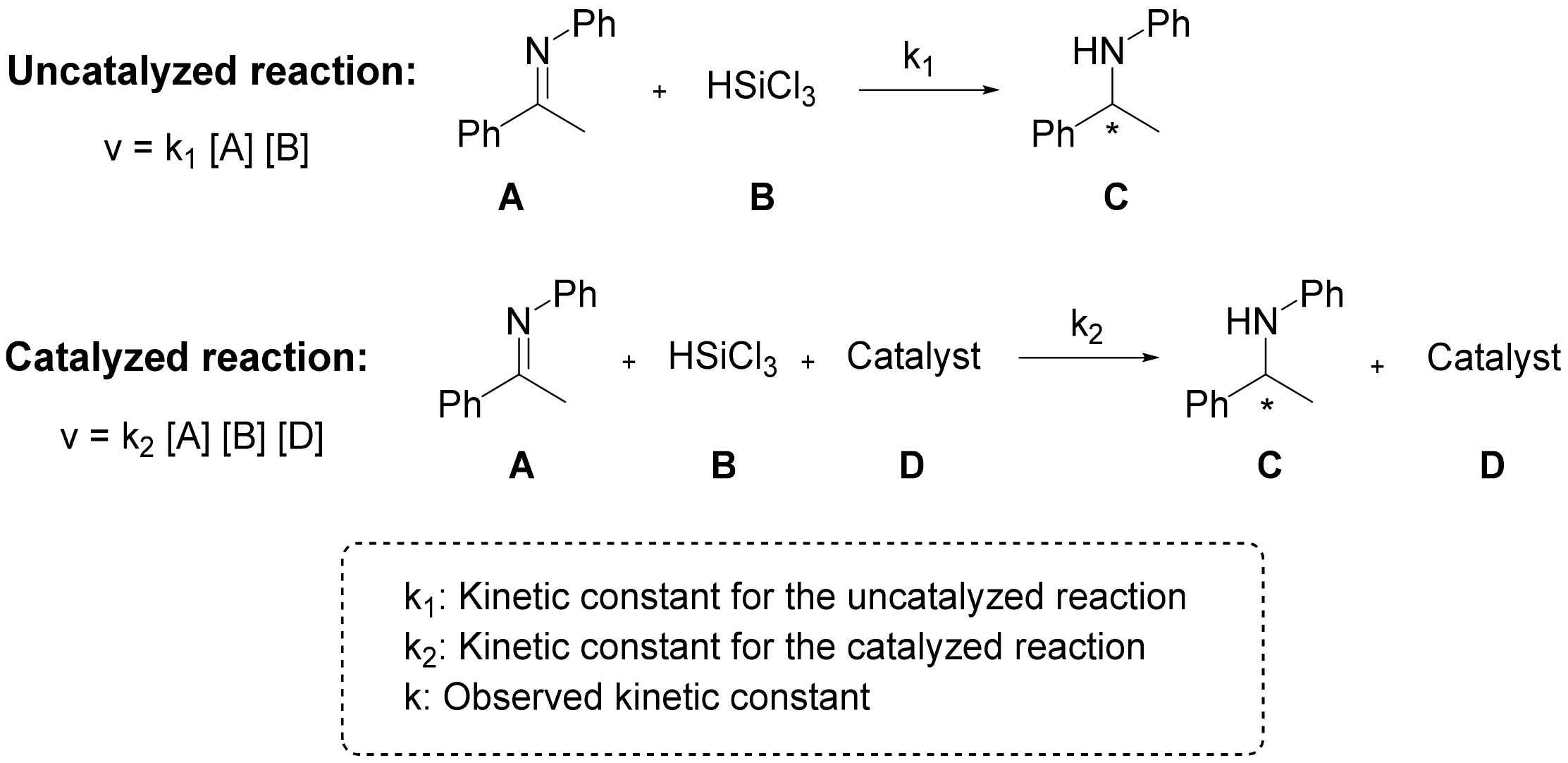

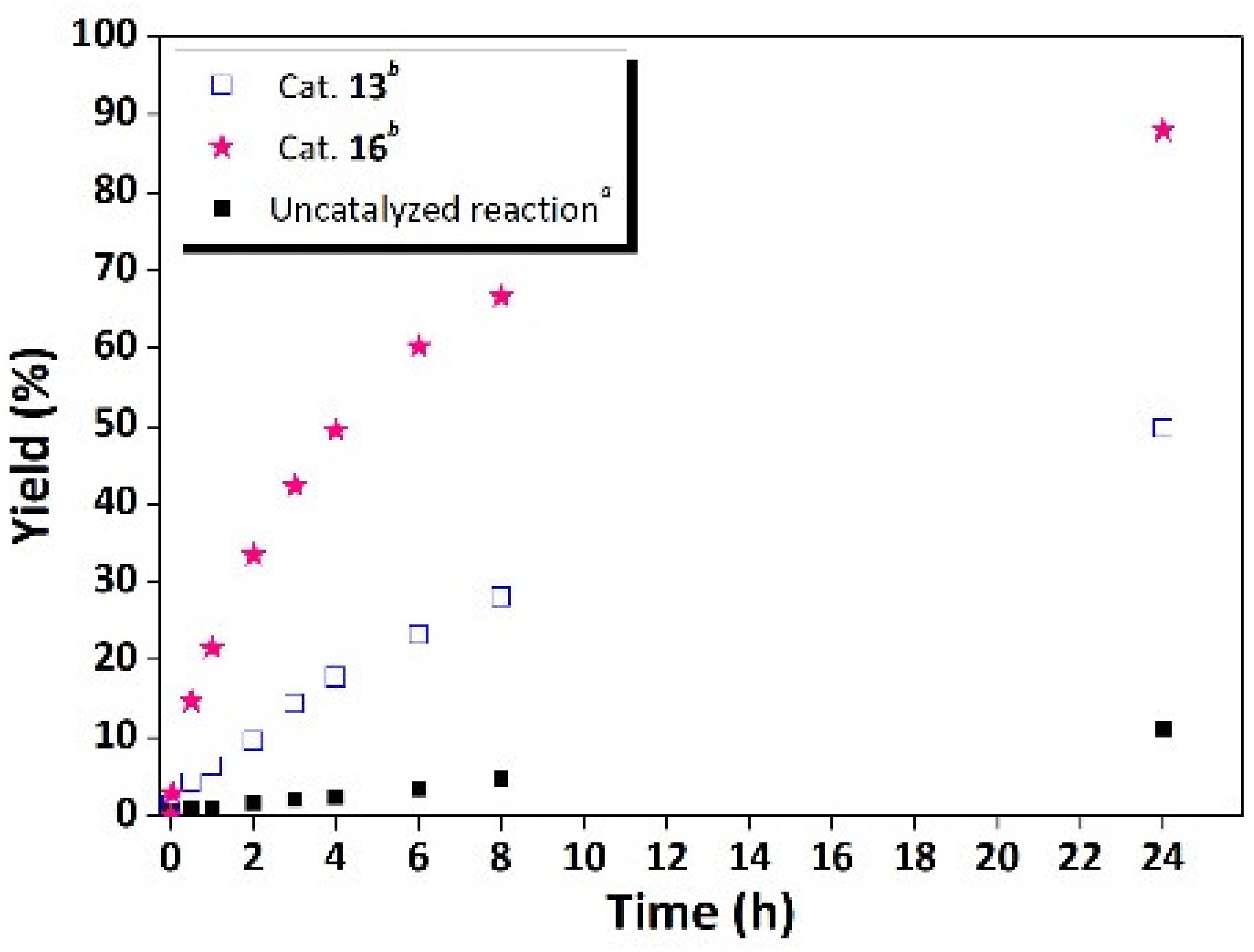

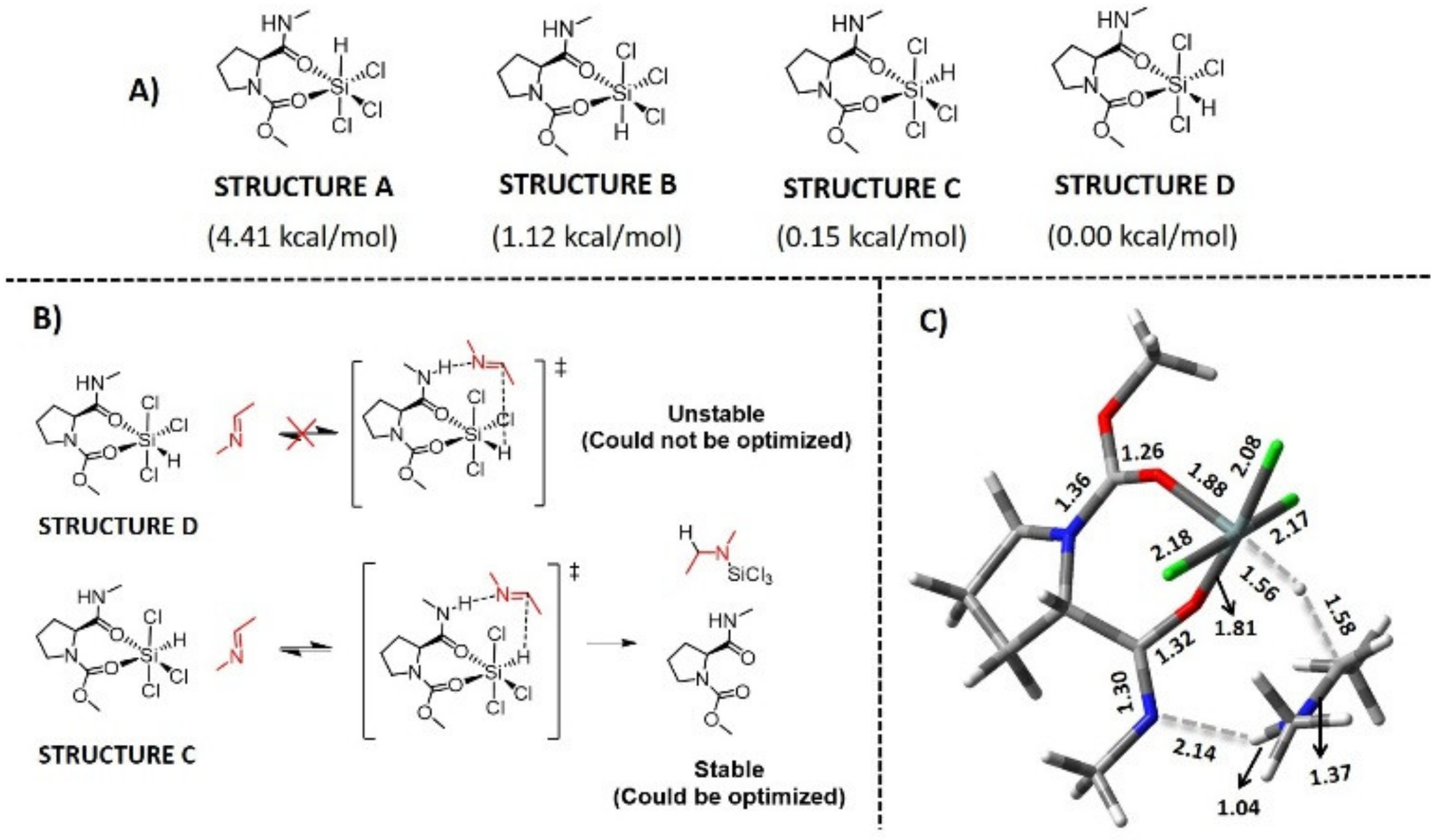


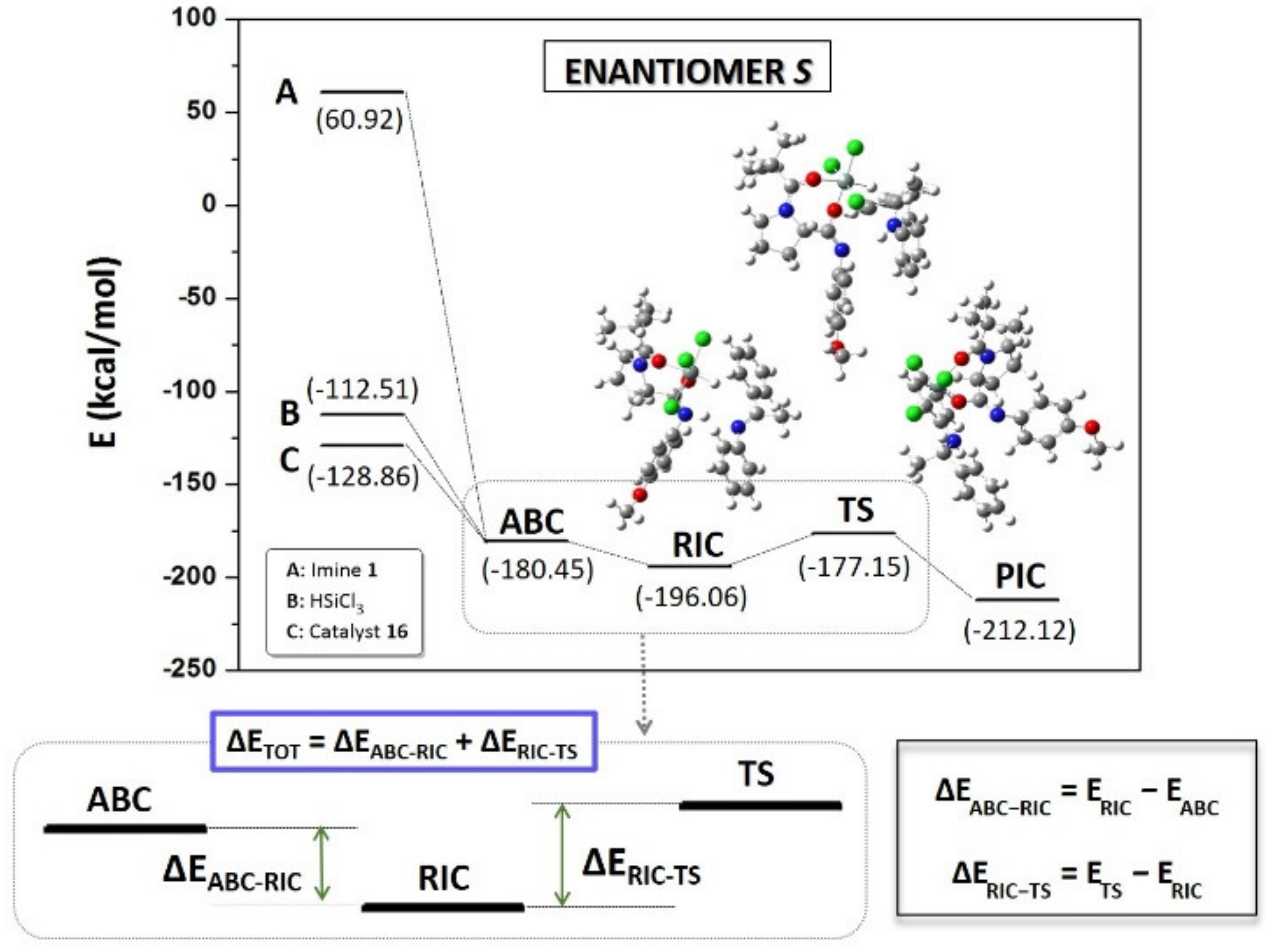

| Entry | Catalyst | Conv. b (%) | Yield b (%) | eec (%) |
|---|---|---|---|---|
| 1 d | - | - | 23 | 0 |
| 2 | 3 | 91 | 91 | 85 |
| 3 | 4 | 98 | 83 | 85 |
| 4 | 5 | 99 | 95 | 0 |
| 5 | 6 | 99 | 94 | 81 |
| 6 | 7 | 98 | 97 | 82 |
| 7 | 8 | 99 | 99 | 88 |
| 8 | 9 | 93 | 91 | 0 |
| Entry | Catalyst | k (M−1 h−1) | k2 (M−2 h−1) | k2/k1 (M−1) |
|---|---|---|---|---|
| 1 | - a | 0.00543 c | - | - |
| 2 | 3b | 0.04000 | 0.5238 | 96.5 |
| 3 | 6b | 0.01124 | 0.0880 | 16.2 |
| 4 | 8b | 0.03647 | 0.4703 | 86.6 |
| Entry | Cat. | k (M−1 h−1) | k2 (M−2 h−1) | k2/k1 (M−1) | eeexpb (%) |
|---|---|---|---|---|---|
| 1 | 12 | 0.02617 | 0.3142 | 57.8 | 77 |
| 2 | 13 | 0.04326 | 0.5732 | 105.5 | 79 |
| 3 | 14 | 0.00591 | 0.0073 | 1.3 | 10 |
| Entry | Cat. | mol% Cat. (%) | [Cat] (M) | Conv. b (%) | Yield b (%) | eec (%) | ACE |
|---|---|---|---|---|---|---|---|
| 1 | 15 | 1 | 0.005 | 99 | 99 | 81 | 47.87 |
| 2 | 15 | 5 | 0.026 | 99 | 99 | 82 | 9.69 |
| 3 | 15 | 40 | 0.205 | 99 | 99 | 82 | 1.21 |
| 4 | 16 | 1 | 0.005 | 96 | 88 | 86 | 49.05 |
| 5 | 16 | 5 | 0.026 | 100 | 100 | 87 | 11.28 |
| 6 | 16 | 40 | 0.205 | 99 | 99 | 86 | 1.38 |
Publisher’s Note: MDPI stays neutral with regard to jurisdictional claims in published maps and institutional affiliations. |
© 2021 by the authors. Licensee MDPI, Basel, Switzerland. This article is an open access article distributed under the terms and conditions of the Creative Commons Attribution (CC BY) license (https://creativecommons.org/licenses/by/4.0/).
Share and Cite
Maciá, M.; Porcar, R.; Martí-Centelles, V.; García-Verdugo, E.; Burguete, M.I.; Luis, S.V. Rational Design of Simple Organocatalysts for the HSiCl3 Enantioselective Reduction of (E)-N-(1-Phenylethylidene)aniline. Molecules 2021, 26, 6963. https://doi.org/10.3390/molecules26226963
Maciá M, Porcar R, Martí-Centelles V, García-Verdugo E, Burguete MI, Luis SV. Rational Design of Simple Organocatalysts for the HSiCl3 Enantioselective Reduction of (E)-N-(1-Phenylethylidene)aniline. Molecules. 2021; 26(22):6963. https://doi.org/10.3390/molecules26226963
Chicago/Turabian StyleMaciá, María, Raúl Porcar, Vicente Martí-Centelles, Eduardo García-Verdugo, Maria Isabel Burguete, and Santiago V. Luis. 2021. "Rational Design of Simple Organocatalysts for the HSiCl3 Enantioselective Reduction of (E)-N-(1-Phenylethylidene)aniline" Molecules 26, no. 22: 6963. https://doi.org/10.3390/molecules26226963
APA StyleMaciá, M., Porcar, R., Martí-Centelles, V., García-Verdugo, E., Burguete, M. I., & Luis, S. V. (2021). Rational Design of Simple Organocatalysts for the HSiCl3 Enantioselective Reduction of (E)-N-(1-Phenylethylidene)aniline. Molecules, 26(22), 6963. https://doi.org/10.3390/molecules26226963







